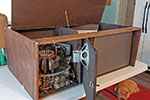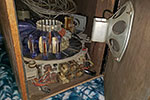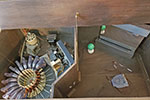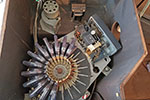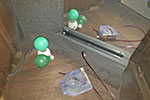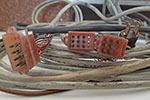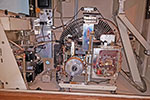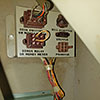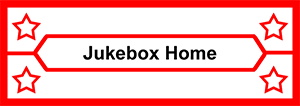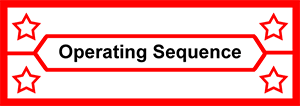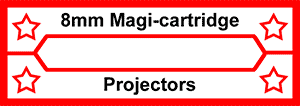Repair and refurbishment of a 1971 AMI/Rowe MM5 Presidential jukebox and a PhonoVue PV1
Introduction
There are a couple of people I have to thank for providing me with information about the PhonoVue and hence these pages. Gert Almind writes the Danish Jukebox Archives and David Platek, who is one of the experts on these machines.
Shortly after starting work on the jukebox I read that AMI Rowe made something called a PhonoVue for the MM series of jukeboxes. What this unit does is play short, less than 3-minute long, loops of Super 8mm film to accompany the music. In May 2022, I started looking around for one of these units and as luck would have it, found one. It took a 2,300 mile round trip from June 22 to June 26, 2022 to bring it home from Quebec City, Canada.
Here's what it looked like the day I got it home...
Like the jukebox itself, getting the PhonoVue to work is going to be very much a learning on the job project.
On the rear wall of the jukebox, on the right, behind the coin chutes is a junction box. This is shown but not named in the service manual. It does not appear to be the Bonus Relay (part no. 302-03519) but that looks to be incorporated into the unit. It looks to have been adapted at some in the past to allow permanent free play of the jukebox. Interestingly and more to the point, it contains a socket for a PhonoVue unit.
Parts
Adapter Kit
In my naivety, I thought all I needed was the PhonoVue unit and everything would be fine. It is not. When new, these units came with an adapter kit and those are very rare and near impossible to obtain. What appears to have happened was that when the PhonoVue units were removed from the jukeboxes and sold, nearly always, they were simply unplugged and the adapter kits left inside the jukebox.
The units were made between 1968 and 1972 and designed to be made with any of 1100 mechanisms which were used in the JAl and JEL jukeboxes from 1962 to presumably the R-83 from 1979. This includes all the Music Master (MM) jukeboxes from 1966 to 1972, but the adapter kits were slightly different.
Circuit Board and Wiper Assembly
This extra board and wiper provides a select signal for the correct movie to be played and were fitted to the jukebox's search unit. Early units such as the JAl and JEL (1962), JBM (1963), JAN (1965), and JAO (1966) need holes drilled to fit the adapter, later units were predrilled.
Relay Box
The relay box provides timing and controls the PV1 from the jukebox.
The Films
There were 13 magi-cartridges that came with the PhonoVue. The labels had come off four of them so I do not know what those are. The others were:
| Serial | Title | Style | Duration |
|---|---|---|---|
| L-2914 E | Warming Up | Rock ‘n Roll | 2:17 |
| L-2914 Z | Knockout | Rock ‘n Roll | 2:50 |
| L-2915 P | Nervous Bride | Instrumental | 2:29 |
| L-2915 Z | Tourist’s Dream | Rock ‘n Roll | 2:20 |
| L-2916 B | All Kinds of Muscle | Instrumental | 2:35 |
| L-2922 S | School is Out | Rock ‘n Roll | 2:24 |
| L-2924 G | Light My Fire | Rock ‘n Roll | 2:33 |
| L-2924 J | By the Sea | Rock ‘n Roll | 2:15 |
| L-2927 C | Club Hopping | Rock ‘n Roll | 2:13 |
One of the films, L-2924 J, By the Sea has split but should be fairly easily to splice together.
First Play
After a quick visual check that nothing was obviously wrong with it and after reading the manual, I carried out the Initial Checkout Procedure. The manual says that this should be done before connecting the PhonoVue to the jukebox, which I cannot do anyway as I am still looking for the connection kit.
The first time the PhonoVue has played anything in several years
In June 2024, a viewer of the video on YouTube and Reddit identified the belly dancer. Her name was Özel Türkbaş (September 1, 1938 – July 22, 2012). Originally from Turkey, she settled in the US but continued to work in both countries. She helped popularize belly dancing and appeared in 14 films, made 5 albums and wrote two books.
The PhonoVue version of the film is "All Kinds of Muscle" but it was originally called "Daughter of the Nile" when it appeared on a Scopitone 16mm film loop. That version is on Vimeo and a colour version on Historic Films starting at 37:45. The film was made by Continental Cinema Corporation in 1967.
From the 1968 International Television Almanac, Continental Cinema Corporation was based at Studio City, North Miami, Florida. 949-2211. Milton H. Lehr was president, Lawrence S. Rapport was chairman and secretary, David Brady was vice-president. The company produced of films, commercials, TV specials and series.
I contacted David Platek, an expert on these machines, and he offered some very useful advice as to what might be wrong with the mechanism.
Magi-cartridges and Projectors
Chan Gade in the AMI Classic Jukebox Collectors Facebook Group said that the optics in the PhonoVue were based on the Technicolor Super 510 film projector which had a 20-32mm zoom lens and played the 8mm Magi-cartridge film loops.
The Magi-cartridges were popular is schools at one time and a variety of companies produced both the projectors and cartridges. The Technicolor Instant Projector could project Magi-cartridges. The Optical Toys site has a brochure for Technicolor's range of Instant projectors.
Other makers of the Magi-cartridges were Ealing and Technicolor.
ERIC (Education Resources Information Center) / Institute of Education Sciences has a document called Lesson Guide for Captioned Films from 1972 that mention 8mm film loops. I do not know if these were Magi-cartridges or some other type.
RoweVue
Not to be confused with PhonoVue, RoweVue was a system of showing slides on a 9" x 6" screen in the top panel of the jukebox. The device would show a series of 8 35mm slides one at a time at 15 second intervals. The mechanisms were made for the MM2 which was first produced in 1968, it could also be fitted to the MM3 and MM4 series. Not all MM2, MM3 or MM4 jukeboxes had the RoweVue fitted and the space for the screen would often be covered with a picture. A feature on the MM3 in the January 11, 1969 issue of Cash Box says that:
A proven merchandising feature that has been continued and improved upon is the RoweVue slide program, which capitalizes on the attention-getting aspect of animation. Rowe provides 150 slides with each phonograph . . . including Sports, Beautiful Girls, Record Artists, Food and Beverage, and others. The RoweVue system holds eight slides and the projection system on the machine shows a new slide every 15 seconds. Barton [Rowe's vice president for domestic sales Joe Barton] summarized the RoweVue program, "Once we entice a prospective customer to the phonograph to get a better look at the slides. 50% of the job of getting him to play the phonograph is done."
The full benefit of the RoweVue feature is realized, however, when operators work with their locations to customize slides to fit the interests of a local group. Slides that feature customers, employees, and special items, such as local events, are bound to capture the casual glance.
A major breakthrough in serviceability has been achieved by changing the position of the RoweVue unit so that it is now serviced from the front.
Pinball Rebel has some nice photos of an AMI Rowe MM3 with a RoweVue fitted. On a MM2, the screen was in the center of the top panel. Available as an optional extra for the MM4, the screen was on the left of the panel.
Other Video Jukeboxes
The AMI Rowe PhonoVue was not the first accessory that allowed jukeboxes to play films. Film-based jukeboxes have been around from 1940 with the Panoram which played 16mm film loops called Soundies. I have no personal knowledge of these machines so whatever I write would simply a rewriting of other people's work. Rather than do that, here are some keywords that can be used to look-up more information.
CAMECA - Makers of the Scopitone
Cinebox/Colorama - The Cinebox was a 1959 machine that played 16mm film. It was renamed Colorama in 1965 in the US.
Cinejukebox - "A deluxe version of the Cinebox"
Color-Sonics - a 1966 machine that played 8mm film loops.
Colorama - Produced by Cinebox in 1966.
Panoram - a 1940 machine that played 16mm film loops called Soundies.
Scopitone - a 1960 machine that played colour 16mm film loops. The last films for the Scopitone were made in 1978.
Soundies - the 16mm film loops used by the Panoram. They were made from 1940 to 1947.
Websites to start with are:
Danish Jukebox Archives
Michele Bovi
Mills Panoram
Scopitone Archive
Scopitone - The Visual Jukebox (Internet Archive)
Scopitone: '60s Music Videos You've Never Seen
Scopitone and Cinebox
More Information
Danish Jukebox Archives - A history of the jukebox. This site also contains a list of films that were made for the AMI/Rowe PhonoVue system
ERIC (Education Resources Information Center) / Institute of Education Sciences has a document called Lesson Guide for Captioned Films from 1972 that mention 8mm film loops. I do not know if these were Magi-cartridges or some other type.
Jukebox Arcade - These sell the service manual for the PhonoVue
Jukebox World - A German site about jukeboxes. Contains some great information about the AMI/Rowe jukeboxes, PhonoVue, and Wallboxes
Optical Toys has a brochure for Technicolor's range of Instant projectors
PhonoVue HD on YouTube by David Platek demonstrates a PhonoVue
Pinball Rebel - Has some nice photos of the MM5 and PhonoVue. Also home of the GraphicStripper - Title strips (online PDF creator)
